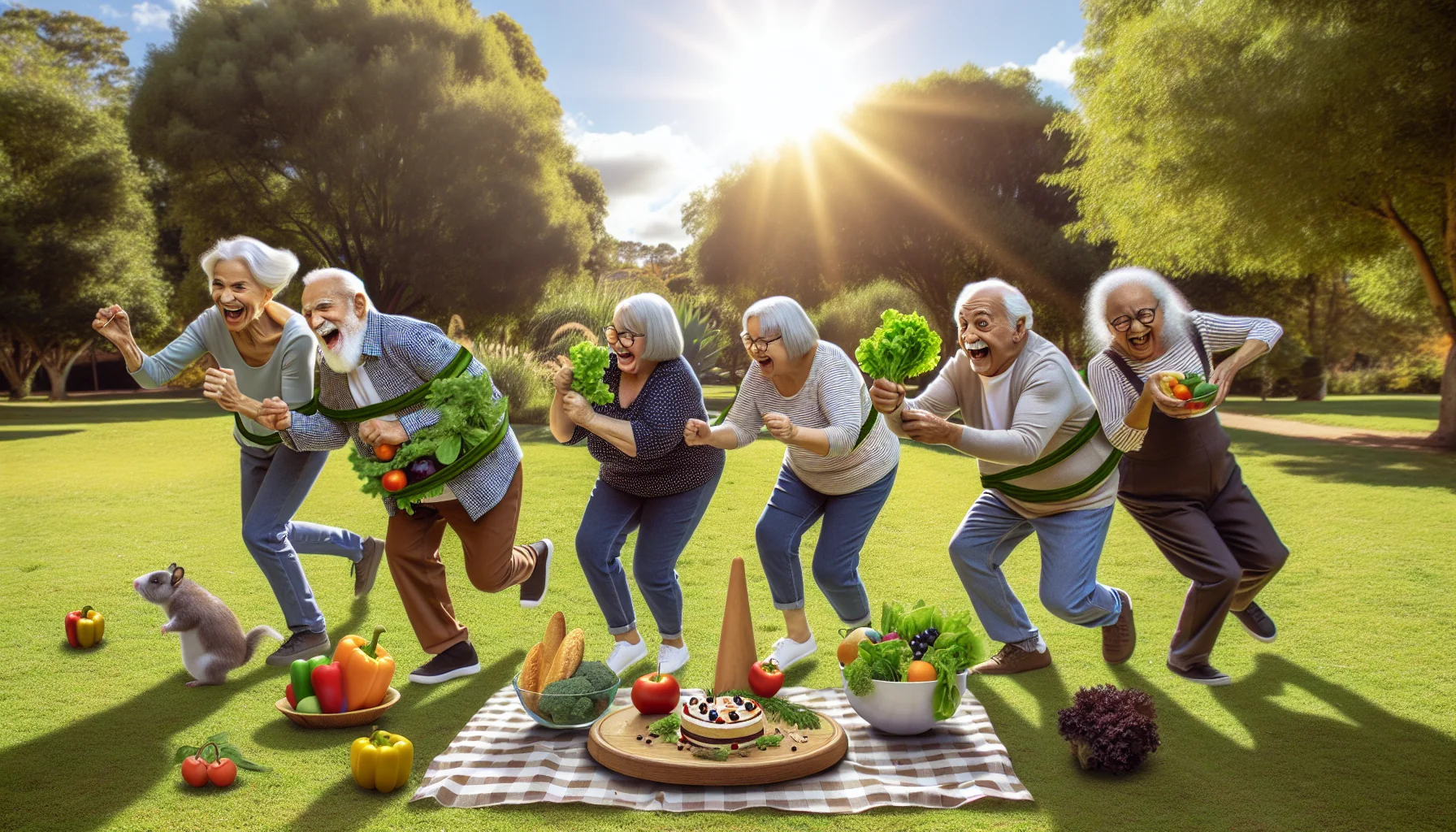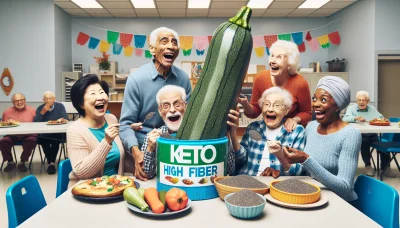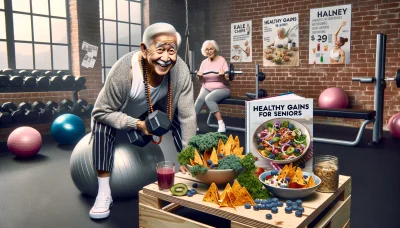Healthy aging month Quiz
Test Your Knowledge
Question of
Understanding Healthy Aging Month
Significance of Healthy Aging Month
Healthy Aging Month is a time to focus on the positive aspects of growing older and to inspire individuals to improve their physical, mental, social, and financial well-being. It's a call-to-action for adults to rejuvenate their lifestyles by adopting healthier habits.
This annual observance is crucial for promoting longevity and enhancing the quality of life as one ages. By spotlighting health and wellness, it motivates adults to take charge of their health through various activities and routines that foster vitality.
Throughout Healthy Aging Month, preventive health measures are emphasized to reduce the risk of chronic diseases. The campaign encourages regular check-ups, screenings, and vaccinations to maintain optimal health at every stage of life.
Raising awareness about age-related issues is another pivotal aspect of Healthy Aging Month. It serves as an educational platform that disseminates information on managing common conditions associated with aging and provides strategies for healthy living.
Promoting Longevity and Well-being
In celebrating Healthy Aging Month, we acknowledge the advancements in medicine and technology that contribute to increased life expectancy. Embracing a proactive approach towards health can lead to a more fulfilling and extended lifespan.
Well-being extends beyond physical health; it encompasses emotional and psychological resilience. Activities that promote social interaction, lifelong learning, and mental agility are vital for maintaining a sharp mind and a robust spirit.
Encouraging Preventive Health Measures
Preventive health care plays a significant role in healthy aging by identifying and mitigating potential health issues before they become serious. This proactive approach is essential for sustaining long-term health and independence.
Adopting healthy eating habits, regular exercise, adequate sleep, stress management, and abstaining from harmful behaviors like smoking can dramatically lower the risk of many age-related diseases. These lifestyle choices are powerful tools in the quest for healthy aging.
Raising Awareness About Age-Related Issues
Educational initiatives during Healthy Aging Month shine a light on common challenges faced by older adults. From cognitive decline to mobility issues, understanding these conditions is key for prevention and management.
Social support systems play an integral role in addressing age-related issues. Communities are encouraged to create environments where older adults can thrive through accessible healthcare services, inclusive activities, and supportive infrastructure.
How to Participate in Healthy Aging Month
Community Events and Activities
Participating in community events is a fantastic way to engage with Healthy Aging Month. Cities often host fitness classes tailored for older adults, health fairs offering free screenings, or seminars on nutrition and wellness.
Becoming involved in local activities not only benefits personal health but also fosters community bonds. By joining group walks or attending cultural events geared towards seniors, individuals can enjoy social interaction while pursuing a healthier lifestyle.
Educational Resources and Workshops
- *Take advantage of libraries or community centers offering lectures on topics such as retirement planning or chronic disease management. *Look out for workshops that teach new skills or hobbies which can keep the mind active while providing a sense of accomplishment. *Utilize online platforms that offer courses specifically designed for seniors wanting to expand their knowledge or stay current with technology. *Seek out resources provided by local healthcare organizations that educate on managing medications or navigating the healthcare system effectively.
Volunteering and Advocacy Opportunities
Beyond personal development, Healthy Aging Month is an opportune time to give back through volunteering. Sharing skills with younger generations or aiding fellow seniors can be immensely rewarding experiences.
Advocacy plays a crucial role as well. Seniors can use their voices to influence policy changes that improve the lives of older adultswhether its campaigning for better healthcare services or promoting age-friendly communities.
The Role of Diet in Aging Gracefully
Nutritional Needs for Seniors
As we age, our bodies undergo significant changes that impact nutritional requirements. Seniors need a well-rounded diet rich in nutrients to maintain muscle strength, bone health, and overall vitality. It's crucial to focus on nutrient-dense foods that provide the maximum health benefits per calorie consumed.
Essential Vitamins and Minerals: Older adults need an increased intake of certain vitamins such as B12, D, and calcium. These are vital for cognitive function, bone density, and preventing age-related diseases. Foods like leafy greens, lean meats, and fortified cereals can be excellent sources.
Managing Caloric Intake with Age: Metabolism slows down with age, necessitating a careful balance of caloric intake. Seniors should aim for a diet that is lower in calories but high in protein and fiber to sustain energy levels and promote satiety.
Hydration and Its Importance: Staying hydrated is often overlooked but is essential for seniors. Water supports every cell in the body, aids digestion, and helps prevent urinary tract infections and constipation. An adequate intake of fluids also supports cognitive function and overall health.
Common Dietary Concerns for Older Adults
The golden years bring a set of common dietary concerns that can affect one's quality of life. Addressing these issues proactively can make a huge difference in aging gracefully and maintaining independence.
Addressing Decreased Appetite: A diminished sense of taste or appetite can lead seniors to consume less than what their bodies require. Enhancing food flavors naturally or setting regular eating schedules can help mitigate this issue.
- Avoid skipping meals; consistency is key.
- Incorporate a variety of colors and textures to make meals more appealing.
- Use herbs and spices instead of salt to enhance flavor without increasing blood pressure risk.
- Eat nutrient-rich snacks like nuts or cheese between meals to boost calorie intake if needed.
- Stay social by sharing meals with others whenever possible.
Combatting Chronic Health Conditions: Many seniors manage chronic conditions that can be influenced by diet. Heart disease, diabetes, and osteoporosis are just a few examples where dietary adjustments can have profound effects on disease management and progression.
Ensuring Digestive Health: Digestive issues are common in older adults due to changes in the gastrointestinal system. Consuming fiber-rich foods like fruits, vegetables, whole grains, along with adequate hydration, promotes digestive regularity and prevents common ailments like constipation.
Anti-Aging Foods to Incorporate into Your Diet
Superfoods for Healthy Aging
Unlock the secret to a youthful glow with nature's marvels superfoods! These nutrient powerhouses are essential for combating the signs of aging, providing a blend of vitamins, minerals, and antioxidants that shield your body from cellular damage. Integrating these foods into your diet can lead to incredible health benefits and slow down the aging process.
Superfoods not only enhance your physical well-being but also invigorate your mental acuity. They're loaded with compounds that combat inflammation, a key culprit in chronic diseases and age-related decline. By making superfoods a staple in your meals, you're setting the stage for a healthier, more vibrant you!
Berries and Their Antioxidant Power
Berries are nature's sweet defense against the ravages of time. Each tiny fruit is packed with antioxidants like vitamin C and anthocyanins, which wage war on free radicals that cause aging. Indulge in strawberries, blueberries, raspberries, or blackberries to keep your skin radiant and your body fortified against disease.
The delightful burst of flavor in berries isn't just for your taste budsthey're also a boon for brain health. Regular consumption can help maintain cognitive function and may even delay memory decline. It's a delicious way to nurture your mind as you age!
Leafy Greens and Cognitive Health
Leafy greens are not just side dishes; they're formidable allies in preserving your mental sharpness. Vegetables like spinach, kale, and swiss chard are rich in vitamins A, C, E, and K, which have been linked to preventing cognitive decline. Make them a daily fixture on your plate to harness their brain-protecting prowess.
Eating greens can be a fountain of youth for your brain cells. The nutrients found in these vegetables help reduce stress on the brain and promote an environment conducive to cell growth. It's simple: leafy greens today could mean more lucid tomorrows!
Nuts and Heart Health
Nuts are the crunchy guardians of heart health. Almonds, walnuts, and pistachios contain monounsaturated fats that support healthy cholesterol levels and blood vessels. Embrace these tasty morsels as part of your daily diet to bolster heart function and longevity.
Don't overlook nuts as powerful tools in managing weighta factor crucial for aging well. Their satisfying combination of protein, fiber, and healthy fats can help regulate appetite and prevent overeating. Snack on a handful of nuts instead of processed treats to keep both heart and waistline happy.
Foods to Boost Immunity and Vitality
Your immune system is the bedrock of longevityfortify it with foods designed to enhance its function. Choosing edibles that are rich in certain nutrients can give you an edge against illnesses and infections that come with age. By focusing on immunity-boosting foods, you can maintain vitality throughout the years.
The right foods have the power not only to heal but also energize you from within. They work synergistically with your body's natural defenses by improving gut health and reducing inflammationkey factors in sustaining robust immunity as you age.
Citrus Fruits for Vitamin C
Citrus fruits are synonymous with Vitamin Ca champion of immune support. Oranges, lemons, limes, and grapefruits offer a refreshing zest along with their health perks. Integrating these juicy delights into your diet ensures a steady supply of this essential vitamin which helps fortify your body's natural barriers against pathogens.
But Vitamin C does more than just guard against coldsit also aids in collagen production for supple skin! So by savoring citrus fruits regularly, you're not only boosting immunity but also nurturing a youthful complexiona win-win scenario!
Probiotic-Rich Foods for Gut Health
- *Yogurt: Look for labels stating "live active cultures" for maximum benefits. *Kefir: A fermented milk drink teeming with probiotics. *Sauerkraut: Choose unpasteurized versions which contain live bacteria. *Kimchi: This spicy Korean dish is another excellent source of probiotics. *Miso: A Japanese seasoning made from fermented soybeans. *Kombucha: A fizzy tea-based beverage known for its probiotic content. *Pickles: Go for naturally fermented varieties where vinegar wasn't used in the pickling process. *Tempeh: A firm tofu-like product offering both protein and probiotics. *Traditional Buttermilk: The leftover liquid from making butter contains probiotics (cultured buttermilk generally does not). *Certain Cheeses: Gouda, mozzarella, cheddar, and cottage cheese can be probiotic-rich if labeled "made with raw milk" or "naturally fermented."
Omega-3 Fatty Acids from Fish
Fish high in omega-3 fatty acids are veritable elixirs for aging bodies. Salmon, mackerel, sardinesand even certain plant sources like flaxseedsoffer these vital fats which play an instrumental role in maintaining cell membrane integrity throughout our bodies.
Incorporating omega-3s into one's diet has been linked to reduced inflammationan underlying factor in many chronic diseasesand improved neurological function. Plus, they support heart health by balancing blood lipid profiles; it's truly food that cares for you as you age.
Dietary Patterns for Longevity
Unlock the secrets of a longer, healthier life through the power of dietary patterns! It's no mystery that what we eat has a profound impact on our longevity. Embark on an exhilarating journey as we explore diets that have stood the test of time, and learn how you can incorporate their wisdom into your daily routine for a vibrant future!
Witness firsthand how traditional eating habits from around the globe are not just about food, but also about a philosophy of life. These diets, rich in history and culture, offer more than just nutrition; they promote a harmonious balance between body and nature, guiding you towards a path of well-being and extended lifespan. Get ready to transform your diet into a life-enhancing elixir!
Mediterranean Diet and Its Benefits
Dive into the Mediterranean Diet and discover a treasure trove of health benefits! Characterized by an abundance of fresh fruits, vegetables, whole grains, and heart-healthy fats, this diet is a beacon of wellness. Embrace this culinary adventure and witness your health flourish in ways you never imagined!
Renowned for its colorful palette of foods and flavors, the Mediterranean Diet is not just a meal planit's a lifestyle. By adopting this diet, you're not just eating differently; you're embarking on a transformative journey that nurtures both body and soul. Let's delve into its components and reap the bountiful rewards!
Heart Health and Olive Oil
Experience the magic of olive oila cornerstone of the Mediterranean marvel! This liquid gold is not only delicious but also packs a punch when it comes to cardiovascular protection. Rich in monounsaturated fats, it's your heart's ally against disease. Make olive oil your kitchen staple and watch your heart thank you for years to come!
With each drop of olive oil, envision strengthening your heart's fortitude. Say goodbye to harmful saturated fats and welcome this heart-healthy alternative with open arms. Transform your meals with its rich flavor while safeguarding your most vital organthe heart!
Whole Grains and Fiber Intake
Say hello to whole grains, the unsung heroes in the quest for longevity! These fiber-packed wonders are essential in maintaining digestive health and keeping hunger pangs at bay. Swap out refined grains for their whole counterparts and unlock endless benefitsfrom weight management to reduced risk of chronic diseases.
Embrace whole grains like barley, quinoa, and farro as your dietary staples. They're not only versatile but also brimming with nutrients that support overall health. Make room on your plate for these fibrous treasures and enjoy their life-extending properties!
Plant-Based Proteins and Legumes
Transform your protein intake with the power of plants! Legumes such as lentils, chickpeas, and beans are stars in the Mediterranean dietboasting high protein content without the saturated fat found in animal products. They're key players in promoting longevity while delighting your taste buds.
- Incorporate legumes into salads or stews for a nutrient-rich meal.
- Experiment with hummus or bean dips as tasty snacks or appetizers.
- Mix up your protein sources by trying different types of legumes throughout the week.
- Leverage legumes' versatility by using them in both hot dishes and cold salads.
- Savor the benefits of plant-based proteins by making them a central part of your diet.
The Okinawa Diet: Lessons from the Long-Lived
Inspired by Okinawa's centenarians, this diet is a testament to optimal health through low-calorie yet nutrient-dense foods. It emphasizes vegetables, whole grains, fruits, legumes (especially soy), fish, lean meats, nuts, and seedsall consumed in moderation. Discover how this ancient wisdom can forge your path to longevity!
Low-Calorie, Nutrient-Dense Foods
Okinawa's dietary secret lies in its emphasis on low-calorie foods that are rich in vitamins and mineralsthink sweet potatoes as their staple rather than high-caloric processed foods. This approach contributes to lower body weight while providing all necessary nutrients for sustained energy levels and overall vitality.
The Role of Soy in Longevity
Soy takes center stage in Okinawan cuisineoffering powerful health benefits tied to longevity. It's packed with isoflavones linked to reduced risk factors for cardiovascular disease and certain cancers. Incorporating tofu or edamame into meals could be an easy step towards a longer life span.
Managing Weight as You Age
Aging is a journey that comes with various challenges, and managing weight is a significant one. It's not just about aesthetics; it's about health, mobility, and quality of life. As metabolism naturally slows down, staying proactive about weight management becomes more crucial than ever.
Understanding the body's changing needs and adapting to them can help maintain a healthy weight through the golden years. This article provides actionable strategies and addresses common hurdles faced by seniors in their pursuit of a balanced lifestyle.
Strategies for Maintaining a Healthy Weight
Balancing Macronutrients Effectively
Balanced macronutrient intake is vital for anyone looking to maintain a healthy weight. As you age, your body requires fewer calories, but the need for nutrient-dense foods increases. Prioritizing lean proteins, complex carbohydrates, and healthy fats can keep you full and energized.
Adjusting your diet to include more whole foods like fruits, vegetables, whole grains, and lean meats can make a big difference. It's not just about reducing calorie intake; it's about making every calorie count with nutrient-rich choices.
Regular Physical Activity and Exercise
Regular physical activity is a cornerstone of weight management at any age. For older adults, incorporating a mix of cardiovascular exercises with strength training can help combat muscle loss and boost metabolism.
Finding activities you enjoy ensures that exercise remains a consistent part of your routine. Whether it's walking, swimming, yoga, or dancing, regular movement is essential for maintaining muscle tone and cardiovascular health.
Mindful Eating Practices
Mindful eating encourages awareness of hunger cues and helps prevent overeating. Taking the time to savor each bite can lead to better digestion and greater satisfaction with smaller portions.
- Eat without distractions such as TV or smartphones.
- Chew food thoroughly to aid digestion and improve satiety.
- Pause between bites to gauge your level of fullness.
- Choose smaller plates to help control portion sizes.
Addressing Weight Loss Challenges in Seniors
Coping with Metabolic Changes
The metabolic rate declines as we age, meaning the body burns fewer calories at rest. Understanding this change is key to adapting dietary habits accordingly. A focus on metabolism-boosting foods like protein-rich meals can mitigate these effects.
In addition to diet adjustments, engaging in activities that promote muscle mass can help keep your metabolism more active. Resistance training is particularly effective in preserving muscle tissue that burns more calories even at rest.
Dealing with Mobility Restrictions
Mobility restrictions can pose significant challenges to maintaining an active lifestyle. However, there are numerous low-impact exercises designed to accommodate limited mobility while still providing health benefits.
Aquatic exercises, seated workouts, or even simple stretching routines can contribute significantly to caloric expenditure. Its important to consult with healthcare professionals for personalized exercise plans tailored to individual mobility levels.
Emotional Eating and Stress Management
Emotional eating can become a barrier to weight management among seniors. Recognizing triggers and finding alternative coping mechanisms for stress is vital for maintaining healthy eating habits.
Incorporating stress-reduction techniques such as meditation, deep breathing exercises or engaging in hobbies can divert the mind from emotional eating tendencies. Seeking social support from friends or professional counseling can also be beneficial in managing stress-related eating habits.
Planning a Healthy Aging Diet
Creating a Balanced Meal Plan
A balanced meal plan is the cornerstone of healthy aging. It should include a diverse range of foods from all food groups, ensuring adequate intake of essential nutrients. Proportionality is key, with an emphasis on fruits, vegetables, whole grains, lean proteins, and healthy fats. Tailoring this balance to individual energy needs helps maintain a healthy weight and supports overall well-being.
When considering portion control and meal timing, it's crucial to listen to your body's hunger cues. Regularly spaced meals and controlled portions prevent overeating and can help stabilize blood sugar levels. This approach aids in digestion and can boost metabolic health, which is particularly important as we age.
It's easy to fall into dietary ruts, but incorporating variety is vital for nutritional adequacy. Each food group offers unique nutrients; therefore, rotating choices within these categories can enhance diet quality. Colorful plates typically indicate a broad spectrum of vitamins and minerals, so aim for diversity in hues and flavors.
Adapting recipes for healthier options doesn't have to be daunting. Simple swaps like using olive oil instead of butter or choosing whole-grain pasta can make a significant difference. Experimenting with herbs and spices instead of salt enhances flavor without increasing sodium intakea small change with substantial heart health benefits.
Seeking Professional Guidance for Dietary Needs
As dietary needs evolve with age, consulting with a registered dietitian becomes increasingly beneficial. These professionals provide evidence-based advice tailored to individual health profiles. They can also offer strategies for managing dietary restrictions while ensuring nutritional needs are met.
For those managing health conditions such as diabetes or heart disease, personalized nutrition plans are critical. A dietitian will account for medical history, current medications, and specific nutritional requirements when creating a diet plan. This personalized approach supports disease management and may improve quality of life.
- Regular Assessments: Continuous monitoring ensures the diet evolves with changing health needs.
- Feedback Loops: Open communication with healthcare providers allows for real-time adjustments to dietary plans.
- Educational Resources: Dietitians provide materials that help understand the why behind dietary choices.
- Diverse Dietary Strategies: Multiple approaches cater to different lifestyles and preferences, ensuring sustainability.
- Motivational Support: Professional guidance often includes encouragement and motivation to adhere to dietary changes.
Maintaining an optimal diet requires continuous monitoring and adjustments. Aging individuals should have regular check-ins with their healthcare team to refine their meal plans as necessary. This dynamic approach accommodates changes in metabolism, activity levels, and health status over time.












